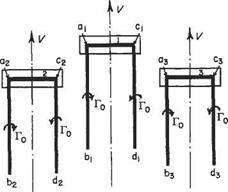Formation flying effects
Aircraft flying in close proximity experience mutual interference effects and good estimates of these influences are obtained by replacing each aircraft in the formation by its equivalent simplified horseshoe vortex.
Consider the problem shown in Fig. 5.15 where three identical aircraft are flying in a vee formation at a forward speed V in the same horizontal plane. The total mutual interference is the sum of (i) that of the followers on the leader (1), (ii) that of the leader and follower (2) on (3), and (iii) that of leader and follower (3) on (2). (ii) and
(iii) are identical.
|
|
Fig. 5.15
components from the trailing vortices a2b2 and сзёз – The net result is an upwash on the leader.
(ii) These wings have additional influences to their own trails due to the leader and the other follower. Bound vortex aiCi and trailing vortices aibi, a2b2 produce downwashes. Again the net influence is an upwash.
From these simple considerations it appears that each aircraft is flying in a regime in which upward components are induced by the presence of the others. The upwash components reduce the downward velocities induced by the aircraft’s own trail and hence its trailing vortex drag. Because of the reduction in drag, less power is required to maintain the forward velocity and the well-known operational fact emerges that each aircraft of a formation has a better performance than when flying singly. In most problems it is usual to assume that the wings have an elliptic distribution, and that the influence calculated for mid-span position is typical of the whole wing span. Also any curvature of the trails is neglected and the special forms of the Biot-Savart law (Section 5.2.2) are used unreservedly.












